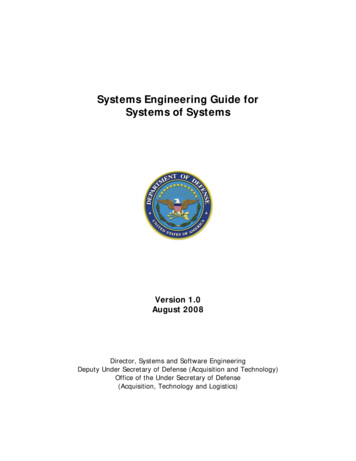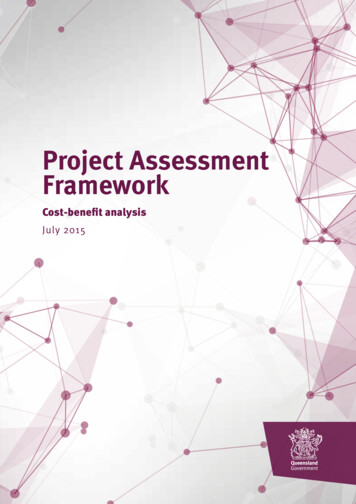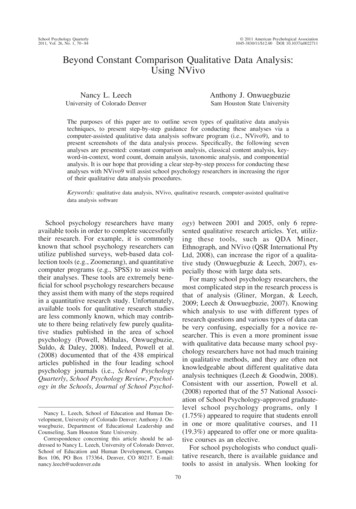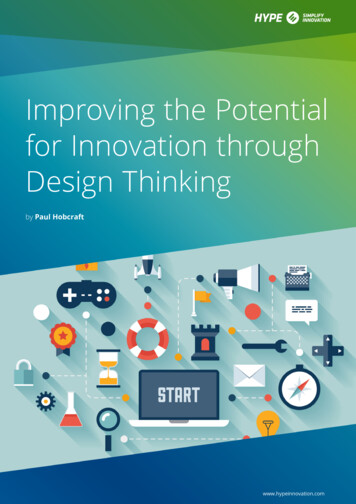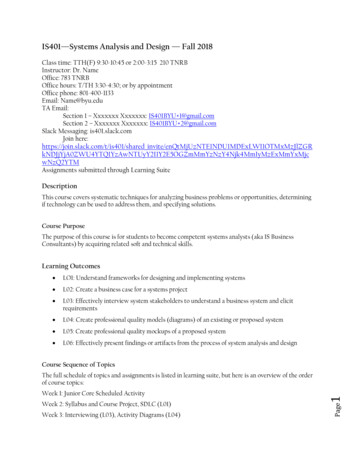
Transcription
IS401—Systems Analysis and Design — Fall 2018Class time: TTH(F) 9:30-10:45 or 2:00-3:15 210 TNRBInstructor: Dr. NameOffice: 783 TNRBOffice hours: T/TH 3:30-4:30; or by appointmentOffice phone: 801-400-1133Email: Name@byu.eduTA Email:Section 1 – Xxxxxxx Xxxxxxx: IS401BYU 1@gmail.comSection 2 – Xxxxxxx Xxxxxxx: IS401BYU 2@gmail.comSlack Messaging: is401.slack.comJoin here:https://join.slack.com/t/is401/shared mYxMjcwNzQ2YTMAssignments submitted through Learning SuiteDescriptionThis course covers systematic techniques for analyzing business problems or opportunities, determiningif technology can be used to address them, and specifying solutions.Course PurposeThe purpose of this course is for students to become competent systems analysts (aka IS BusinessConsultants) by acquiring related soft and technical skills.Learning Outcomes LO1: Understand frameworks for designing and implementing systems L02: Create a business case for a systems project L03: Effectively interview system stakeholders to understand a business system and elicitrequirements L04: Create professional quality models (diagrams) of an existing or proposed system L05: Create professional quality mockups of a proposed system L06: Effectively present findings or artifacts from the process of system analysis and designCourse Sequence of TopicsWeek 2: Syllabus and Course Project, SDLC (L01)Week 3: Interviewing (L03), Activity Diagrams (L04)PageWeek 1: Junior Core Scheduled Activity1The full schedule of topics and assignments is listed in learning suite, but here is an overview of the orderof course topics:
Week 4: Data Flow Diagrams (L04)Week 5: Use Case Diagrams, Class Diagrams (L04)Week 6: Exam Review and ExamWeek 7: Sequence Diagrams and UI (L04, L05)Week 8: UI and Planning (L05, L02)Week 9: Planning and Design (L02,L04)Week 10: Design Patterns (L04), Presenting Findings (L06)Week 11: Presentations (L01)Week 12: No class (Holiday)Week 13: Exam Review and Exam 2Week 14: Integrative Exercise (L01-L06)Week 15: Deployment and Support (L01) and Final Exam ReviewWeek 16: FinalTextSystems Analysis and Design, Distilled. Free ebook. Name. 2018.Also, assigned readings from additional sources that will be posted on Learning Suite.Primary AssessmentsIn order to gauge your progress with respect to the learning outcomes in the course, you will first learnabout a new concept and then progress from formative through summative assessments. Formativeassessments are initial tests of your understanding in which you will receive feedback on performing askill, usually without any deductions, and summative assessments are typical percentage-basedassignments and exams. Formative assessments in this class are comprised of open-book quizzes, classexercises, and homework assignments (full points given for completion). Summative assessments willbe as follows: Three exams spread throughout the course, one semester-long group project, and the oneweek-long integrative exercise. All three exams will include true/false, multiple choice, short answerquestions. The first two exams will also include a take home portion that challenges you to solve aproblem.Grade CategoriesPage2Grades will be assigned based on achievement in the categories below.
DescriptionPercent of GradeHomework, Reading Quizzes10%Participation10%Exam 115%Exam 215%Final Exam15%Semester Project20%Integrative Exercise15%Homework and Reading Quizzes: Homework will be primarily completion-based and reviewed in class.Typical homework assignments will involve reading a story problem and then creating an assigned typeof diagram from that problem. Quizzes will be open book and related to the readings. They are meant toprepare you for class discussions.Participation: Each student will automatically be assigned 80% for participation at the beginning of thesemester. To have the grade go higher, a student must do the following: Do a short group presentation on failed software projects Discuss your individual homework solution at least once in class Actively contribute to course discussions (ask questions, share experiences, be social) Participate in the semester-long group project presentation Support other students in their learning and outside of classOn each exam I will ask you to report on what you perceive to be your participation efforts as it relates tothis list. I’d also like to take a moment to announce that your verbal (not just physical presence)participation in my class and others will weigh heavily into the discussions that occur about MISMprogram admissions. Speaking frankly, I think the MISM is of more value to someone that is a clearfuture leader as evidenced by their class and overall program participation than someone who getsperfect grades but never opens their mouth. Also, one of the highest percentages of jobs for IS graduatesis in consulting (a direct off-shoot of this course), and so being willing to interact socially about IS topicsis critical.Exam 1: In-class portion (keywords, concepts, rules) as well as an applied diagramming portion (solve aproblem as you would in the real world).Exam 2: In-class portion (keywords, concepts, rules) as well as an applied diagramming portion (solve aproblem as you would in the real world).Final Exam: Testing center. Keywords, concepts, rules.Semester Project: Opportunity to demonstrate fulfillment of course purpose by utilizing all course skills.Integrative Exercise: Opportunity to demonstrate fulfillment of course purpose by utilizing all course skills.PageThe Marriott School mandates that the course average may not be higher than 3.6. Usually I raise gradesat the end of the semester to meet this average. This semester I’ve made it easier to get 100% onhomework and quizzes, so it is possible that I will round down to meet the GPA requirement.3Grading
Consequently, I can’t say definitively what the letter grade/percentage breakdown will be. However, Iwill use the following grade rules as my starting point (prior to any curve adjustments):A, A94-100%, 90-93.9%B , B, B- 87-89.9%, 84-87.9%, 80-83.9%C , C, C- 77-79.9%, 74-76.9%, 70-73.9%D ,D,D- 67-69.9%, 64-66.9%, 60-63.9%E0 – 59.9%If you ever have concerns about how I'm grading you, please visit with me about it.Extra CreditI encourage you to participate in SONA research activities. You can apply up to 4 research credits at 5points each (out of an estimated 600 points in this category) to the Homework/Quizzes portion of theclass. Hence, you can add up to 20 points to the homework/quiz section.Additional extra activities will be announced as available. Last semester 5 points were awarded toHomework/Quizzes by following BYU IS on instragram: Instagram.com/byu isClass MechanicsEach week in class will focus on a new topic related to you becoming a systems analyst (IS businessconsultant). Before class: Typically, each new topic will involve one or more readings and an open book quiz In class: We will discuss the quiz, discuss concepts from the readings, and do activities (typicallyin groups) that relate to applying the concepts learned in the readings and class discussion. Wewill end class with a sample question that could be on an exam based on that day’s activities After class: Typically, there will be a homework assignment that provides practice related to thetopic discussed in class. This homework assignment will be reviewed the next day of class.Course ToolsStudents in the BSIS program can participate in the Microsoft Academic Alliance called Imagine. Thismeans that all MS development software is free for student use – both in the lab and on your homepersonal computer. To download, follow the links at dreamspark.byu.edu. You must be registered in anIS course to have access to this software.Drawing Tools: All diagrams created in this course must be submitted in a computer drawn format. Youmay use any drawing tool, but I recommend learning Lucidchart. We will also learn Microsoft Visiobecause it has historically been the market leader for software and business modeling.Project Tools: We will use Microsoft Project to develop project schedules for your project. It is expectedthat you will receive training on this in your project management course, but I also have tutorialsavailable. MS Project is available in the lab and via Imagine.PageLate Assignments: Late homework will not be accepted. It is like the public bus, if you miss it, you haveto wait for the next one. With 120 students, I get several daily notices saying “I forgot” for quizzes andhomework. Due dates will be clearly posted and consistent. The only exceptions are for major life issueslike hospitalization, death in the family, etc.4Homework Policies
Working Together: Daily homework assignments are to be done individually. You are welcome andeven encouraged to discuss the concepts. This discussion will often increase your understanding of thecourse material. However, each person should write his/her own homework using his/her own computerand having his/her own hands on the keyboard. Do not make copies (electronic or paper) of each other'sassignments to turn in.Marriott School PoliciesPlease visit licies for a current description of allMarriott School classroom policies. Some of the highlights include:Academic Honesty: No cheating, do your own work, or discipline will be appliedGrade Distributions: There are required GPAs listed that depend on the type of class (e.g. junior core)Laptops: Use only when instructor leads you to so as not to distract othersPage5Phones: Not allowed outside of bags/pockets during class
Name - Information Systems DepartmentCitizenship Project ProposalBelow, I list specific goals I would like to accomplish by the end of the FDS program and that arecongruent with my longer-term faculty development plan.1.2.3.4.5.6.Organize two department socialsAttend informal lunches with colleagues on a monthly basisParticipate in at least one research project with a colleague in the departmentBegin support of department efforts to host a conference in Salt Lake City in 2020Complete term as president of the Association of Business Information SystemsObserve the teaching of several colleagues and discuss what I learn
May, 2018Name, Information SystemsFACULTY DEVELOPMENT PLANI. Self-assessment on TeachingStrengths:Respectful: I respond with interest and respect in all interactions with studentsCompassionate: I organize student socials each semester and work hard to supportstudents individually in labs. They recognize how much I care for them as noted incourse evaluationsKnowledgeable: I have a rich professional background in many areas of IS which coverstechnical skills as well as management of people within that domain.Enthusiastic: I convey a sense of excitement for the topics that I teachCreative: I am able to create engaging activities related to course conceptsOrganized: I carefully structure courses based on expected learning outcomes. Thetopics selected are sequenced strategically and each day of class is scripted carefully in away that resembles the way that a play has a scriptSelf-assessment of Improvement Opportunities:Subject Matter Expertise: Some classes I teach currently are well within my capability tomaster but they are new to me and so I am still developing competence in themCourse Material Selection and Organization: I need to better vet and select learningmaterials I assign to studentsKnowing Students: Although I try to know the name of every student, there are manythat I forget after initially learning their names, and they feel like I don’t care aboutthem individually. I can do better in this area.Integrating Gospel: I have not attempted to integrate the gospel into my courses on alarge scale. Having learned how to do that recently, I can now attempt this.Student Engagement: During class I need to have better activities and questions thatwill engage them with content and not simply familiarize them with definitions orconcepts.Lecture Quality: My lectures focus too much on PowerPoints currently, and they needto involve more demonstrations, working through problems, alternative media, andstudent activities.Confidence: I have projected a lack of confidence during many lectures in the first yearas I’ve struggled with understanding what the students want from their instructor aswell as feeling uncertain about how to teach content that I haven’t taught before.Goals:
GoalsImprove SubjectMatter ExpertiseImprove CourseMaterial Selection andOrganizationKnow Students BetterPlans1. For courses that I teach in the areas of IT infrastructure, Iwill improve my expertise by:a. Studying for and receiving an industry certification inone of the topic areas (e.g. Azure Cloud, Network )b. Take at least one mini-course (e.g. Udemy) relatedto the topics I teachc. Read industry news weekly related to this contentd. Evaluate new course content for each day of lecture(e.g. videos, websites)e. Do tutorials on my own related to key topics such asrouting with Cisco networking equipment.Measures for these plans:a. Receive at least once certificationb. Report on number of mini-courses takenc. Report on efforts to read weekly newsd. Report on quantity of new content reviewede. Report on quantity and type tutorials completed1. Develop a Systems Analysis and Design ebook. The books inthis area are widely panned by both students and faculty. Iplan to create my own set of readings for each key topic inthis subject area that I feel is important for my students andthen to refine it each year with expanded content, problemsets, etc.Measures for this plan: Approximately 12 written chaptersfor this book, at least 5 pages per chapter.2. Evaluate each and every reading selection for my threecurrent classes (which currently can be as many as 10 perlecture in the data comms class) and re-select/refinereadings for each day of class.Measures for this plan: A statement for each classexplaining how many readings or what percentage ofreadings were updated for each course as well as a reportfrom course evaluations measuring improvement in studentperception of course materials organization related toenhancing learning. I will keep course evaluation numbersin a spreadsheet for each course I teach to facilitatecomparisons across semesters.1. Will attempt to memorize all student names each semester2. In course discussions I will identify students by name whenthey interact publicly with the class (e.g. when theyask/answer questions, etc.).
Integrate the GospelEnhance StudentEngagementImprove LectureQuality3. Will learn unique facts about them and demonstrate that Iremember those facts during class discussions (e.g. “Yes,Jake, champion of the intramural basketball tournament,that is correct”)Measures for these plans: Will give an estimate of thecount/percentage in each of those categories for each course,each semester. The idea is to be able to compare thoseestimates across semesters for a given course. Will also providerelevant course evaluation numbers that relate to studentperceptions of the instructor.1. Will make a conscious effort during the preparation of eachcourse lecture to identify ways to “bake in” gospelprinciples so that it meaningfully enhances student learningwhile also deepens testimonies.Measures for this plan: Qualitative and quantitative reportfor each class, each semester. E.g. “30% of the lectures inthe second semester teaching this course had meaningfulinclusions of gospel content”2. Will hold weekly prayers. Measure for this plan will be areport that it was performed.3. Will highlight and have a discussion of BYU devotionalsfollowing each devotional. Measure for this plan will be areport that is was performed.1. During preparation for each lecture, will seek for ways toengage the students by asking questions or designingactivities that require students to apply what they havelearned from lower level conceptual concepts (decisionbased learning). E.g. “Imagine that you are in the followingsituation what do you do discuss with your group andthen later with the class”Measure for this plan: Report on quantity/percentage oflectures containing these types of activities acrosssemesters for courses. Also, will use evidence from courseevaluations that capture the impact of these activities.2. Invite faculty members to visit class or watch recordedvideos of class and give feedback1. Read at least one book on teaching each year. Measure willbe a report on completing this and what I gained from eachbook that changed how I teach.2. Include more media and on the board diagramming inlectures. Measures will be a summary report on the degreeto which such items are included in course lectures. Also,student evaluations will be compared to assess perceivedimprovement in lectures.
Have more confidence3. Involve more student engagement (see previous goal andplans)4. Invite faculty members to visit class or watch recordedvideos of class and discuss with me their feedback5. Use a SCOT consultant to evaluate lecture quality andengagement in each course I teach1. Will master subject matter (see first goal)2. Will organize content to just include readings/concepts thatI think are important3. Will consciously focus on projecting confidence duringlecturesMeasures for these plans: Be able to report that studentcomments in course evaluations related to confidence havereduced or disappeared.II. Self-assessment on Citizenship and Professional ServiceA. BYU CitizenshipAs a new member of the department, I have limited opportunities for formaldepartment, college, and university service work. Nevertheless, I enthusiasticallypursue the current assignment I have related to conducting department socials. I alsoattend every department meeting possible and share feedback when I can contribute. Iactively participate and prepare for admissions meetings for the undergraduate andmaster’s programs. I attend informal departmental lunches organized by Dr. Gaskinwhenever possible. I support our students by attending several AIS student clubactivities each year. I also support students in the capstone class by attending everypresentation possible, even though I’m not required to be there. I attend graduationactivities regularly and wear my regalia. I offer extra credit in my classes to have mystudents participate in research projects that support the Marriott School. I speak in thePhD prep seminar. Lastly, I actively support recruiting companies that come to campusin their efforts to connect with faculty and hire our students.Possible areas for improvement: I need to look for ways to be a citizen to the BYUcommunity by doing more than just taking on assigned roles and look for ways to servethe university in ways that are voluntary. I can also look for ways to directly support theresearch efforts of members of the department.B. External CitizenshipI currently serve in leadership roles in an association called the Association of BusinessInformation Systems. While at BYU I have served this association as Vice President,Program Chair, and President. Within this organization and its parent organization, the
Federation of Business Disciplines, I have been a positive and public representative forBYU. Although the association and its conference are not considered to be premiere,they (including the parent organization) have a large number of attendees. I have been acompetent researcher and leader in their eyes, and my public association with BYU hasenhanced their appreciation of our university and the Church of Jesus Christ of Latterday Saints.Areas for improvement: Our primary association, AIS, would benefit by having me serveand support it.Goals:GoalsDo more university servicePlay an active role in thedepartmentPlay an active role in theBusiness SchoolSupport a colleague inresearchServe in AIS (Association forInformation Systems)Serve in the Association forBusiness InformationSystems and in its parentthe Federation of BusinessDisciplinesPlans1. Find a positive initiative to be a part of that is notformally assigned or directly solicited, such as regularlydoing Y Serve projects.Measure for this plan: A report on activity performed1. Continue to organize department socials2. Attend informal lunches with colleagues3. Support the requests of faculty and students related tothe IS lab.4. Attend all department meetings5. Support recruiter visits and collaboration6. Collaborate with other Jr. Core faculty to enhance theexperience of the Jr. Core courses7. Invite colleagues to attend devotionals togetherMeasure for these plans: A report on activity performed1. Attend all meetings and socials possible2. Attend graduation exercises (in regalia)Measure for these plans: A report on activity performed1. Participate in at least one research project with acolleague in the departmentMeasure for this plan: A report on activity performed1. Attend AIS meetings/SIGs and find an area in which toserveMeasure for this plan: A report on activity performed1. Continue serving as an officer for ABIS2. Have one conference presentation per year at ABIS3. Serve in a service or leadership role for the Federationof Business DisciplinesMeasure for these plans: A report on activity performed
III. Statement on relationship between individual goals and department and universityaspirations and needsThe Information Systems Department has aspirations and needs that complement those of thebusiness school and the university. Specifically, its mission is to “develop leaders of faith andcharacter who can use, design, implement, manage, and research information systems to makeintelligent organizational decisions.” I listed integrating the gospel into my courses and gettingto know the students better as personal goals. These goals will help deepen student faith in thegospel of Jesus Christ which will in turn help them develop as leaders of faith. I also includedmany goals that emphasize the refinement of subject matter expertise and teaching skills.These goals will facilitate the latter half of the department mission which emphasizes studentskill development within the Information Systems discipline.IV. Resources needed to accomplish teaching/professional goalsResources that I need to accomplish my personal goals at BYU: Funding for travel to conferences and relevant professional meetings. As an officer in anacademic organization, I need modest funds to support travel. I also wish to serve inour primary association, AIS, which will also require travel funds.Software/hardware to support the creation of media related to the courses I teach. Itypically make a lot of videos related to topics that I teach so that students can reviewthem outside of class.Permission to visit the class of colleagues so that I can review their teaching stylesVisits to my class by SCOT consultants as well as colleagues that can visit and review myclassUse resources of faculty center including books (which I hear you can borrow)V. Accomplishments so far in achieving goalsInitial progress related to my goals: I have visited the class of a colleague who is a two-time Bateman Award winner andlearned a lot of good lessons that I can use for my teaching to increase engagement andintegrate the gospel. I also have had multiple meetings with him to discuss my courses.I have written three chapters related to one of my classes that may be included in myproposed systems analysis book project.I have read half the book (Network ) for a certification I could pursue related to a classthat I teach.
Goals for 2nd Semester Teaching Selected CourseMost of the following goals (except the first one), pulled from the faculty development plan,apply directly to the IS 401 Systems Analysis and Design course.GoalsImprove SubjectMatter ExpertiseImprove CourseMaterial Selection andOrganizationPlans1. For courses that I teach in the areas of IT infrastructure, Iwill improve my expertise by:a. Studying for and receiving an industry certification inone of the topic areas (e.g. Azure Cloud, Network )b. Take at least one mini-course (e.g. Udemy) relatedto the topics I teachc. Read industry news weekly related to this contentd. Evaluate new course content for each day of lecture(e.g. videos, websites)e. Do tutorials on my own related to key topics such asrouting with Cisco networking equipment.Measures for these plans:a. Receive at least once certificationb. Report on number of mini-courses takenc. Report on efforts to read weekly newsd. Report on quantity of new content reviewede. Report on quantity and type tutorials completed1. Develop a Systems Analysis and Design ebook. The books inthis area are widely panned by both students and faculty. Iplan to create my own set of readings for each key topic inthis subject area that I feel is important for my students andthen to refine it each year with expanded content, problemsets, etc.Measures for this plan: Approximately 12 written chaptersfor this book, at least 5 pages per chapter.2. Evaluate each and every reading selection for my threecurrent classes (which currently can be as many as 10 perlecture in the data comms class) and re-select/refinereadings for each day of class.Measures for this plan: A statement for each classexplaining how many readings or what percentage ofreadings were updated for each course as well as a reportfrom course evaluations measuring improvement in studentperception of course materials organization related toenhancing learning. I will keep course evaluation numbersin a spreadsheet for each course I teach to facilitatecomparisons across semesters.
Know Students BetterIntegrate the GospelEnhance StudentEngagementImprove LectureQuality1. Will attempt to memorize all student names each semester2. In course discussions I will identify students by name whenthey interact publicly with the class (e.g. when theyask/answer questions, etc.).3. Will learn unique facts about them and demonstrate that Iremember those facts during class discussions (e.g. “Yes,Jake, champion of the intramural basketball tournament,that is correct”)Measures for these plans: Will give an estimate of thecount/percentage in each of those categories for each course,each semester. The idea is to be able to compare thoseestimates across semesters for a given course. Will also providerelevant course evaluation numbers that relate to studentperceptions of the instructor.1. Will make a conscious effort during the preparation of eachcourse lecture to identify ways to “bake in” gospelprinciples so that it meaningfully enhances student learningwhile also deepens testimonies.Measures for this plan: Qualitative and quantitative reportfor each class, each semester. E.g. “30% of the lectures inthe second semester teaching this course had meaningfulinclusions of gospel content”2. Will hold weekly prayers. Measure for this plan will be areport that it was performed.3. Will highlight and have a discussion of BYU devotionalsfollowing each devotional. Measure for this plan will be areport that is was performed.1. During preparation for each lecture, will seek for ways toengage the students by asking questions or designingactivities that require students to apply what they havelearned from lower level conceptual concepts (decisionbased learning). E.g. “Imagine that you are in the followingsituation what do you do discuss with your group andthen later with the class”Measure for this plan: Report on quantity/percentage oflectures containing these types of activities acrosssemesters for courses. Also, will use evidence from courseevaluations that capture the impact of these activities.2. Invite faculty members to visit class or watch recordedvideos of class and give feedback1. Read at least one book on teaching each year. Measure willbe a report on completing this and what I gained from eachbook that changed how I teach.
Have more confidence2. Include more media and on the board diagramming inlectures. Measures will be a summary report on the degreeto which such items are included in course lectures. Also,student evaluations will be compared to assess perceivedimprovement in lectures.3. Involve more student engagement (see previous goal andplans)4. Invite faculty members to visit class or watch recordedvideos of class and discuss with me their feedback5. Use a SCOT consultant to evaluate lecture quality andengagement in each course I teach1. Will master subject matter (see first goal)2. Will organize content to just include readings/concepts thatI think are important3. Will consciously focus on projecting confidence duringlecturesMeasures for these plans: Be able to report that studentcomments in course evaluations related to confidence havereduced or disappeared.
Course Development Project for IS 401 – Grant ProposalName1. This first item in my course development plan is meant to improve teaching by havingpersonal conversations with students over lunch about the course that I teach. The IS401 class has rated less well than other courses in our department for decades. One wayto address this is to have personal discussions with students to better understand howthey are experiencing the content. In other words, a lunch meeting can be viewed as aweekly course assessment. I did a few of these from personal funds last year and foundthat it was highly effective. I teach 120 new students each fall in IS 401 and then havethem for two or three consecutive semesters. I propose that 166.50 be allocated forFall semester lunches, which will support 30 students.2. One activity that I would like to do in class uses rubber balls to teach a technologyframework concept called Scrum in which project estimation gets better over time. Theactivity is based on a published teaching case that I have in my possession. It involveshundreds of rubber balls. I propose to buy a total of 400 rubber balls at a cost of 38.00. bef
Week 9: Planning and Design (L02,L04) Week 10: Design Patterns (L04), Presenting Findings (L06) Week 11: Presentations (L01) Week 12: No class (Holiday) Week 13: Exam Review and Exam 2 Week 14: Integrative Exercise (L01-L06) Week 15: Deployment and Support (L01) and Final Exam Review Week 16: Final . Text . Systems Analysis and Design, Distilled.


